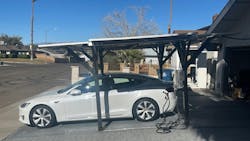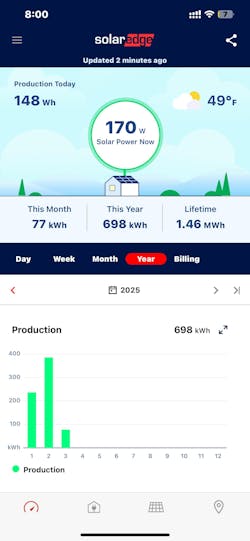Why Can’t Solar and Microgrids Be Plugged in Just Like Hairdryers and Toasters?
At the Freedm Systems Center at North Carolina State University, researchers plugged a 6.3-kW mobile solar generator from Gismo Power into a standard dryer outlet to feed electricity to an electric vehicle (EV) charger.
“If the solar panels are putting out enough power, that's what actually feeds the batteries in the cars. But if it's a cloudy day or it’s night, then we pull power from the building’s grid to charge the EVs,” said Ken Dulaney, director of industry and innovation at the Freedm Systems Center.
“It’s a lower cost way to deploy solar panels,” he added.
As a research institute studying power systems, the center was able to just plug in the solar generator—called a mobile electricity generating appliance–into the university’s own electric grid.
Solar permitting process an obstacle
But if Dulaney had bought the mobile solar system for his house, he would have had to go through the solar permitting process with his local utility, he said. That can be costly and time-consuming.
Avoiding that permitting process and long interconnection queues is one of Gismo Power’s goals. The company, which has received $1.7 million in grants, wants its mobile solar generators, which are available with batteries to create microgrids, to simply be treated like appliances, said Erika Ginsberg-Klemmt, vice president of operations at Gismo Power. The company’s product is an aluminum rack with pivoting side solar panels and removable wheels, basically a solar carport on wheels.
“Why can't we just have solar the way we have a hairdryer, the way we have a washer or some other appliance?” she asked.
Mobile systems for non-millionaires
The mobile solar unit is designed for renters and “non millionaires,” Ginsberg-Klemmt said. The 6.3-kW system costs $24,000. “The moderate income American can afford it, but we have regulatory barriers in the U.S.,” she added. In the U.K., homeowners can simply plug in their solar panels to 240-volt outlets.
“We’re trying to get the biggest bang for the interconnected buck,” she added.
Getting that bang for the buck requires overcoming utility rules, charges and insurance requirements.
In Florida, for example, where Gismo Power is based, Florida Power & Light limits privately owned solar system installations to 115% of past usage and requires owners of systems generating more than a maximum of 10 kW to pay for $1 million in liability insurance.
Connecting mobile microgrids to the grid
Gismo Power isn’t the only company that wants to interconnect its mobile products to the grid. For example, Solarpunks–which recently deployed solar microgrids to help support first responders during the Los Angeles fires–wants to connect its portable units to the grid and potentially offer grid services.
What’s more, bidirectional EVs, serving as mobile microgrids, are gaining ground as a way to provide backup power, support the grid and lower carbon emissions.
Gismo Power, which focuses on homeowners and small businesses, is taking steps at the policy level to create plug-in mobile solar “appliances.”
In Utah, Gismo Power worked with State Rep. Raymond Ward to establish legislation that creates a category for small portable solar generation devices and exempts them from interconnection requirements.
Solar to charge EVs
Chris Boeres, who deployed a Gismo Power solar generator in his son’s driveway and uses it to charge three family EVs, embraces the idea of portable power because it’s in the best interest of people–especially renters and those who move often–to own and not rent their power from the utility, he said. He plans to add energy storage to the system, creating a microgrid.
“When some critical mass of people own their own home power production, that will be the tipping point for the chain reaction that will sweep in new rules,” he said.
The system Boeres deployed is connected to Nevada Energy’s grid, and as of December, has generated 500,000 kWh, according to Boeres’ calculation. The system will generate about $1,200 annually in savings from using the sun to charge the cars, he said.
“Eventually the grid might get to the point where they're screwing over this large population of people who have these self--producing power units, and the producers will say, ‘You know I'm going to put a battery in and I don't need you anymore, Mr. Utility Company,’” Boeres said.
He predicted that utilities will lose hundreds of megawatts in sales to people who generate themselves.
Solar as grid defection
In fact, grid defection is expected to gain momentum. A group of California solar companies wants the solar industry to transform its standard product — solar and storage — into a new offering incorporating electrification and partial grid defection. A paper by the non-profit Agile Electrification and the University of California San Diego Design Lab found that that “65% grid defection” yields optimal savings for California homeowners.
With lower prices of solar and storage, homeowners can decide whether to go off-grid. Like Gismo Power, Maxout Renewables is looking to reduce the price of solar and storage by creating products that serve as appliances.
The company has created an experimental nanogrid–which includes a Gismo Power solar system–in an effort to develop a product less expensive than Tesla powerwalls, said Eric Cummings, president and CEO of MaxOut Renewables.
“We’re trying to create an appliance for $1,000 that uses an inexpensive power source to keep things running overnight, keep the refrigerator going during the day and charge EVs,” he said. This might be a car battery, for example. “We have been trying to bring down the price of solar with whole house backup for regular homeowners,” he added.
Deploying solar and storage as appliances will reap numerous benefits, he said. But before that can happen, regulations and certifications must change.
“The pace of regulation and certification bodies–including the National Electrical Code– aren’t keeping up with reality on the ground. Now that solar is the cheapest energy form ever produced it should not be viewed as a hobbyist thing,” Cummings said.
About the Author
Lisa Cohn
Contributing Editor
I focus on the West Coast and Midwest. Email me at [email protected]
I’ve been writing about energy for more than 20 years, and my stories have appeared in EnergyBiz, SNL Financial, Mother Earth News, Natural Home Magazine, Horizon Air Magazine, Oregon Business, Open Spaces, the Portland Tribune, The Oregonian, Renewable Energy World, Windpower Monthly and other publications. I’m also a former stringer for the Platts/McGraw-Hill energy publications. I began my career covering energy and environment for The Cape Cod Times, where Elisa Wood also was a reporter. I’ve received numerous writing awards from national, regional and local organizations, including Pacific Northwest Writers Association, Willamette Writers, Associated Oregon Industries, and the Voice of Youth Advocates. I first became interested in energy as a student at Wesleyan University, Middletown, Connecticut, where I helped design and build a solar house.
Twitter: @LisaECohn
Linkedin: LisaEllenCohn
Facebook: Energy Efficiency Markets


